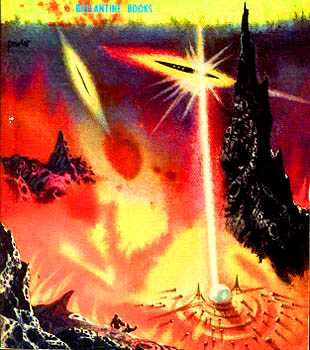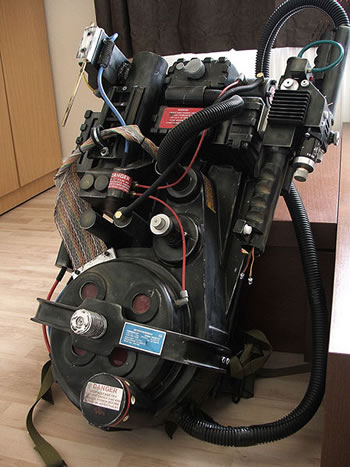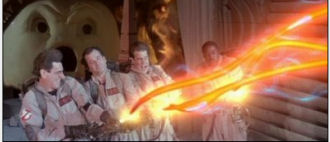|
|
|||
|
..
Stiletto Beam
Several ships are attacking a stationary installation
on the Moon. The ships have the benefit of mobility in attacking a fixed
target; what advantage could the defenders of the installation have that
could turn the tide of battle?
I love this story, and I avoided putting this item on the site for a long time. However, now that DARPA is working on it, I'll put it up. **SPOILER ALERT** Clarke puts the problem this way: "...It looked like a beam of some kind, but of course that's impossible. No beam can be visible in a vacuum."The answer is provided to the reader: He could well appreciate why a jet of molten metal, hurled through space at several hundred kilometers a second by the most powerful electromagnets ever built, might have looked like a beam of light flashing on for an instant.Here's an early Earthlight cover detail. (see above) Additional resources:
SOURCE: http://www.technovelgy.com/ct/content.asp?Bnum=1606
|
|||
|
MAHEM Metal Jets Like Clarke's Stiletto Beam The MAHEM (Magneto Hydrodynamic Explosive Munition) program is a new DARPA project, but to science fiction fans, it is an old, familiar idea. Arthur C. Clarke described the idea in his 1955 novel Earthlight. DARPA is initiating the MAHEM program to try to create compressed magnetic flux generator (CMFG)-driven magneto hydrodynamically formed metal jets and self-forging penetrators (SFP). Self-forging penetrators, as they are currently used, result from a conventional chemical explosion directed against a specially-shaped metal liner. When the device is set off, the blast causes the metal liner to achieve a new shape, suitable for penetrating deep into even moderately armored vehicles, and driven forward at a high velocity. The technology dates back to WWII. This kind of weapon can be highly effective (it is currently being used against troops in Iraq). The drawbacks of this kind of weapon are that they are one-time-use weapons, and cannot efficiently form multiple SFPs from a single charge. If it is possible to use a powerful electromagnet to accelerate a molten jet of metal, it could overcome the drawbacks mentioned above, and even achieve higher velocities and better targeting. DARPA hopes that it could provide the following capabilities: This could provide the warfighter with a means to address stressing missions such as: lightweight active self-protection for vehicles (potential defeat mechanism for a kinetic energy round), counter armor (passive, reactive, and active), mine countermeasures, and anti-ship cruise missile final layer of defense. Science fiction readers have known about this idea for more than a half-century. In his excellent 1955 novel Earthlight, Arthur C. Clarke makes use of exactly this idea in a battle between a stationary facility on the Moon and several attacking space ships. The "beam" was a molten jet of metal hurled into space by enormous electromagnets. Via MAgneto Hydrodynamic Explosive Munition (MAHEM); thanks to MrX_TLO and Winchell Chung for the tip on the story and references. Scroll down for more stories in the same category. (Story submitted 4/23/2008) SOURCE: http://www.technovelgy.com/ct/Science-Fiction-News.asp?NewsNum=1601
|
|||
|
Program Manager: Mr. Roger Hall Overview The Magneto Hydrodynamic Explosive Munition (MAHEM) program will demonstrate compressed magnetic flux generator (CMFG)-driven magneto hydrodynamically formed metal jets and self-forging penetrators (SFP) with significantly improved performance over explosively formed jets and fragments. Explosively formed jets (EFJ) and SFP are used for precision strike against targets such as armored vehicles and reinforced structures. Current technology uses chemical explosive energy to form the jets and fragments. This is highly inefficient and requires precise machining of the metal liners from which the fragments and jets are formed. Generating multiple jets or fragments from a single explosive is difficult, and the timing of the multiple jets or fragments cannot be controlled. MAHEM offers the potential for higher efficiency, greater control, the ability to generate and accurately time multiple jets and fragments from a single charge, and the potential for aimable, multiple warheads with a much higher EFJ velocity, hence increased lethality and kill precision, than conventional EFJ/SFP. MAHEM could be packaged into a missile, projectile or other platform and delivered close to target for final engagement and kill. This could provide the warfighter with a means to address stressing missions such as: lightweight active self-protection for vehicles (potential defeat mechanism for a kinetic energy round), counter armor (passive, reactive, and active), mine countermeasures, and anti-ship cruise missile final layer of defense. Last Updated: 02/18/08 SOURCE: DARPA.MIL |
|||
| DARPA Works to Perfect Self-Forging,
High-Velocity 'Spears'
By Bill Christensen posted: 29 April 2008 06:43 am ET Excerpt: They are calling it MAHEM, which stands for Magneto Hydrodynamic Explosive Munition. The intent is to create a device that creates a powerful enough electromagnetic field to propel streams of molten metal at enemy armor. If it works, the device will be a big improvement on a technology that got its start in World War II — the self-forging penetrator. Self-forging penetrators, as they are currently used, result from a conventional chemical explosion directed against a specially-shaped metal liner. When the device is set off, the blast causes the metal liner to achieve a new shape, suitable for penetrating deep into even moderately armored vehicles, and driven forward at a high velocity. The technology dates back to WWII. This kind of weapon can be highly effective (it is currently being used against troops in Iraq). The drawbacks of this kind of weapon from the standpoint of US military planners is that they are one-time-use weapons, and cannot efficiently form multiple SFPs from a single charge. If it is possible to use a powerful electromagnet to accelerate a molten jet of metal, it could overcome the drawbacks mentioned above, and even achieve higher velocities and better targeting. DARPA hopes that it could provide the following capabilities: "This could provide the warfighter with a means to address stressing missions such as: lightweight active self-protection for vehicles (potential defeat mechanism for a kinetic energy round), counter armor (passive, reactive, and active), mine countermeasures, and anti-ship cruise missile final layer of defense." SOURCE: Space.Com |
|||
|
Ghostbuster Approach To Neutralizing WMD You're a Homeland Security agent. You've located what you believe is a cache of bulk bio-agent. Public safety demands that you neutralize this threat. Who you gonna call? Okay, maybe not the Ghostbusters; but you might be able to make use of their proton pack, according to the Defense Threat Reduction Agency (DTRA). They've recently filed a proposal for Agent Defeat Using Proton Accelerator. One attractive attribute of high energy protons is that they can be focused and stopped at a predetermined point inside the target, where they then deposit most of their energy. For cancer treatment this feature can target deeply buried tumors with minimal effect to surrounding healthy tissue. For agent defeat, this feature may similarly allow a focusing of energy upon pockets of bio-agent contained inside of storage containers or weapons... PHASE III: Perform systems integration and demonstration of a field-deployable proton-beam generator that will fully neutralize bulk bio-agent in warehouse and weapon storage conditions. Just one piece of advice to the Feds - don't cross
the streams.
(Proton pack from the Ghostbusters) Just for fun, the DTRA might want to juice up this backpack laser. Take a look at a real Proton pack; story via Wired. Scroll down for more stories in the same category. (Story submitted 4/21/2008) SOURCE: http://www.technovelgy.com/ct/Science-Fiction-News.asp?NewsNum=1595 |
|||
|
,,
By David Hambling
Proton packs Which team of scientists come charging into action armed with mobile proton accelerators, ready to neutralize terrifying threats to our cities? No, not Ghosbuststers, Inc., though their use of unlicensed particle accelerators to battle evil is well known. Our heroes are the Defense Threat Reduction Agency (DTRA), the arm of the Pentagon tasked with safeguarding the U.S. from Weapons of Mass Destruction. In particular, DTRA is looking for new method for 'agent defeat' –- rendering chemical and biological warfare agents safe -– and a request for proposals titled Agent Defeat Using Proton Accelerator suggests that some real-life Ghostbusters tech might be just the thing:
PHASE I: Perform research and analysis of the generation of high-energy proton beams and the mechanisms of interaction between these high energy proton beams and various bio-agent systems ... And leading up to : PHASE III: Perform systems integration and demonstration of a field-deployable proton-beam generator that will fully neutralize bulk bio-agent in warehouse and weapon storage conditions. It’s a very ambitious scheme, and highly speculative at this stage. Still, the payoff could be very high. Being able to neutralize biological material and explosives at a distance without having to breach the container might be very much safer than exiting methods. And it's not hard to see how many spin-offs would be possible if the technology could be provided cheaply. (Incidentally, crossing the beams from two proton packs, which was supposed to be a deadly hazard in the movies, would not cause any particular problem in real life). So when you find a stockpile of lethal biological weapons, who ya gonna call? SOURCE: http://blog.wired.com/defense/2008/04/ghostbusters-te.html |
|||
| FAIR USE NOTICE: This page contains copyrighted material the use of which has not been specifically authorized by the copyright owner. Pegasus Research Consortium distributes this material without profit to those who have expressed a prior interest in receiving the included information for research and educational purposes. We believe this constitutes a fair use of any such copyrighted material as provided for in 17 U.S.C § 107. If you wish to use copyrighted material from this site for purposes of your own that go beyond fair use, you must obtain permission from the copyright owner. | |||
|
|



